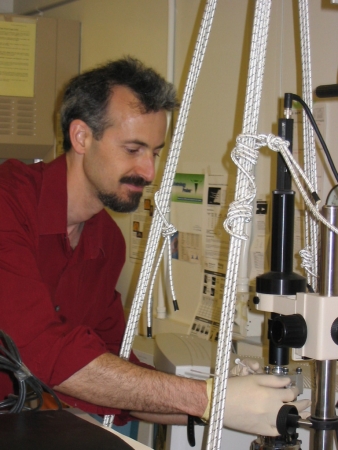
School:
Grade Level:
Teaching Position:
Supervisor:
Department:
Mentor:
Research Project Year:
Research Project Title:
Research Project Description:
Tau protein is thought to play an important structural and functional role in the make-up of microtubules in eukaryotic cells. Bundled microtubules make up the axons of nerve cells or neurons. For neurons to communicate with one another in the brain, the axons must be long and strong enough to make contact with the dendrites of neighboring neurons or severe memory lapses may result. Interestingly enough, tau is found in the axons but not in the dendrites.
Additionally, tau-to-tau attraction and tau aggregations are likely to play an important role in microtubule structure and arrangement during normal neuronal development. However, these tau aggregations also present a molecular mechanism for the tau mediated cell death leading to various Tauopathies, tau associated neurodegenerative diseases such as Alzheimer?s and front temporal dementia. The questions we tried to answer over six weeks were: How does tau bind to mica? And to what extent does tau bind to other tau? We deposited one isoform of tau on mica in three different concentrations. And we used an Atomic Force Microscope (AFM) with a nanoscaled cantilever tip to image in an aqueous environment. We obtained data about the height, width, and volume for the tau deposits and aggregates.
Research Project Attachments:
| Attachment | Size |
|---|---|
| 1.18 MB |
Curriculum Project Year:
Curriculum Project Title:
Curriculum Project Description:
My research project gave me the opportunity to image proteins using the Atomic Force Microscope (AFM), imaging down to approximately 10 nm resolution. The purpose of my curriculum unit is to relate what students are learning in units on Scale, Accuracy, and Forces to 'How do scientists know what they know?' and 'What kind of tools do scientists use?' The National Science Content Standard that relates to this is "Scientists rely on technology to enhance the gathering of data...The accuracy and precision of the data depends on the technology used."
In regard to forces, the students will begin by building a simple force meter and studying the effects of the force applied by the cantilever... 'The greater the displacement of the cantilever (or spring), the greater the force applied by the cantilever (or spring).' This is also known as Hooke's Law.
The students will then build a simple AFM model by varying the type of cantilevers and sizes of the tips (on the end of the cantilevers.) This meets the National Science Content Standard, "The construction of artifacts can require the skills of cutting, shaping, treating, and joining common materials such as wood, metals, and plastics.?
By varying the tip sizes, students will gain an understanding of the importance of having small tips available so that small things can be imaged? An AFM tip needs to be the same size or smaller than what is being imaged to avoid?tip imaging". And a tip needs to be small enough to move between peaks of individual atoms or proteins. According to the California Science Content Standard,"Students will identify and communicate sources of unavoidable experimental error."
Curriculum Project Attachments:
| Attachment | Size |
|---|---|
| 2.34 MB |
